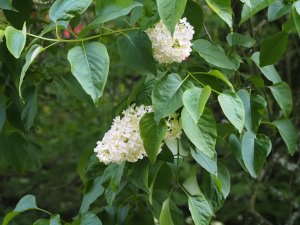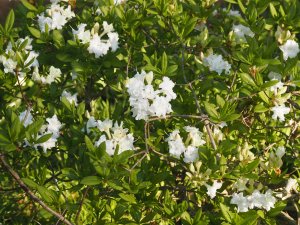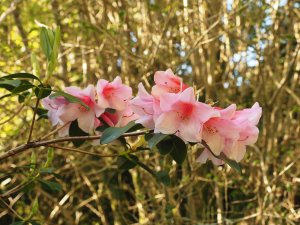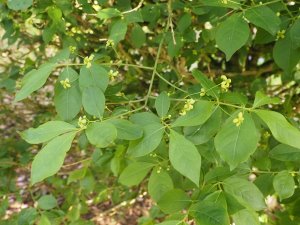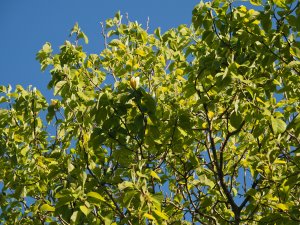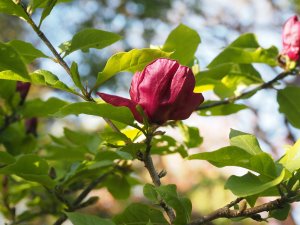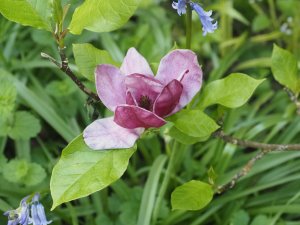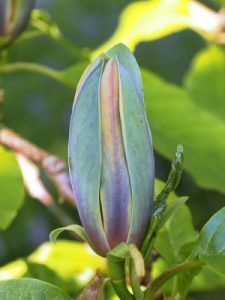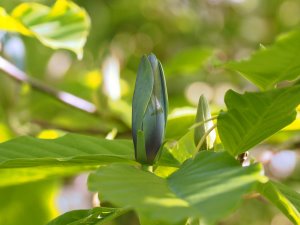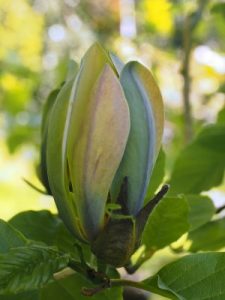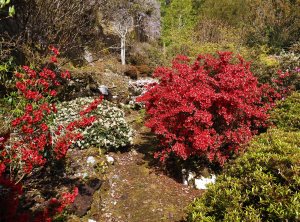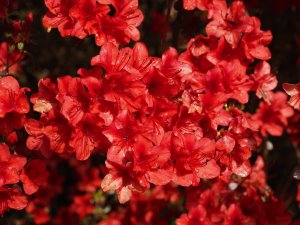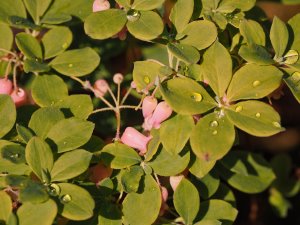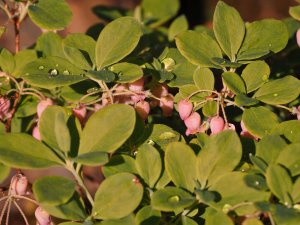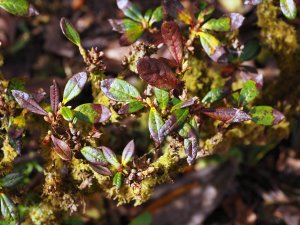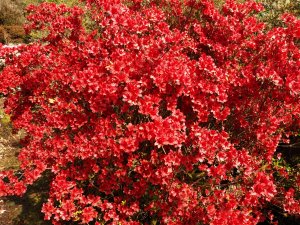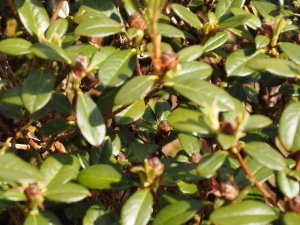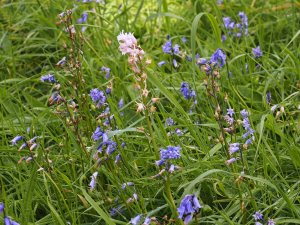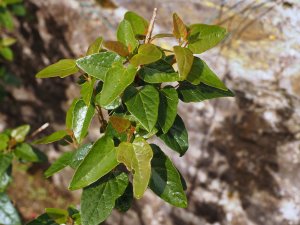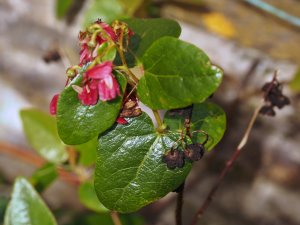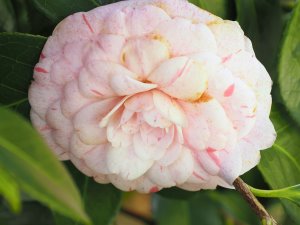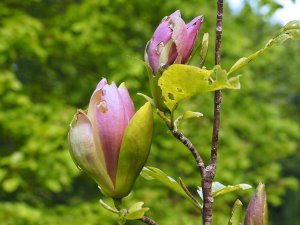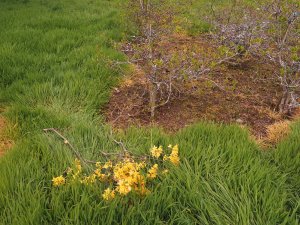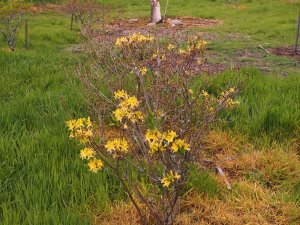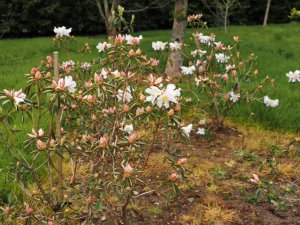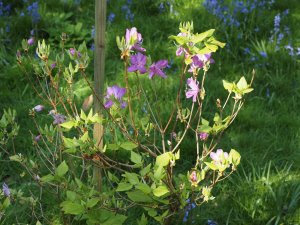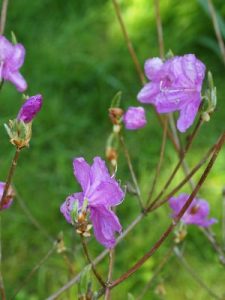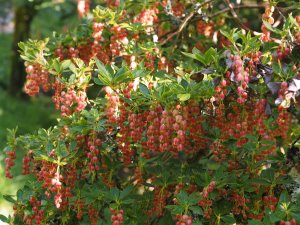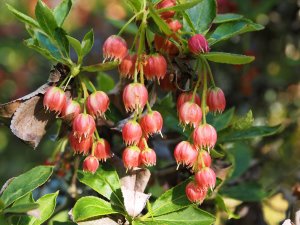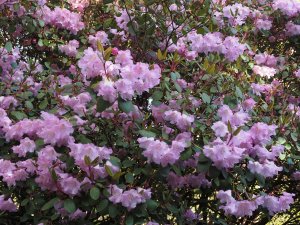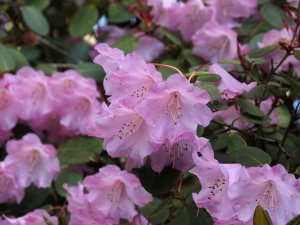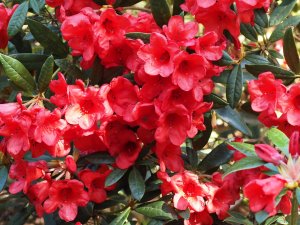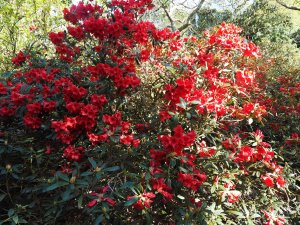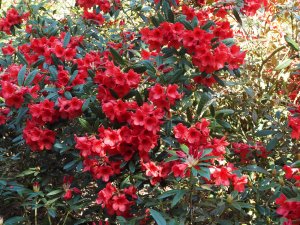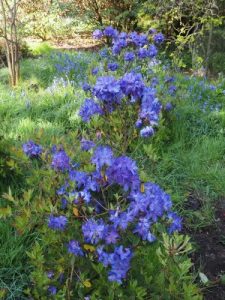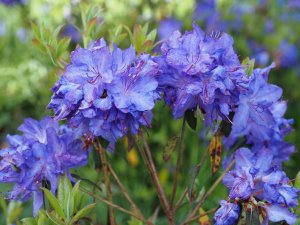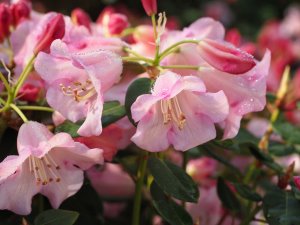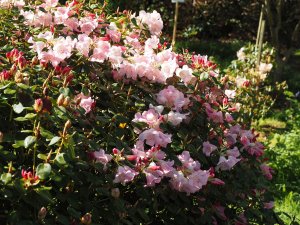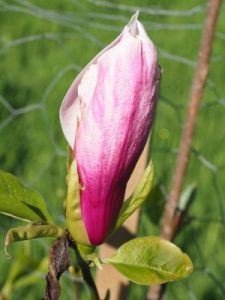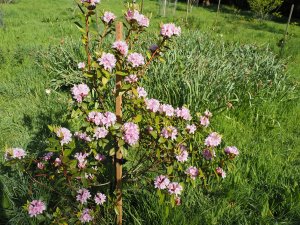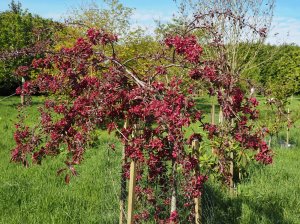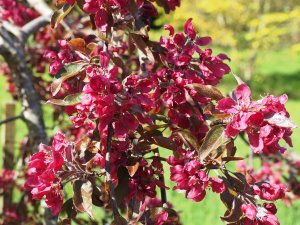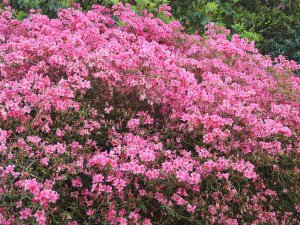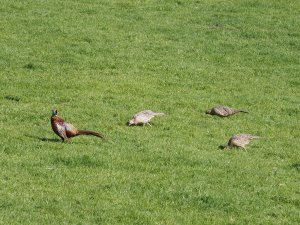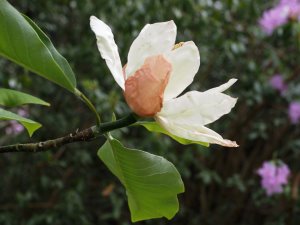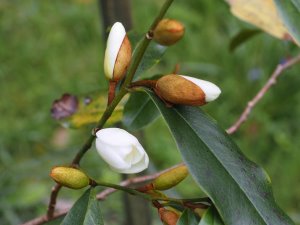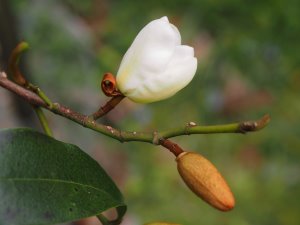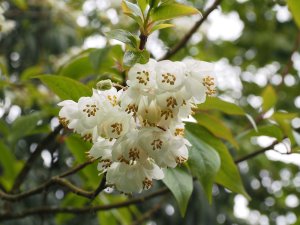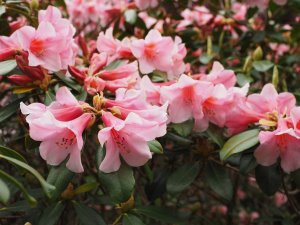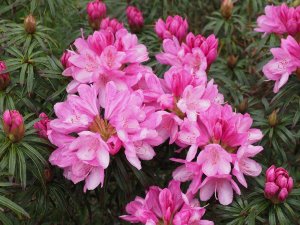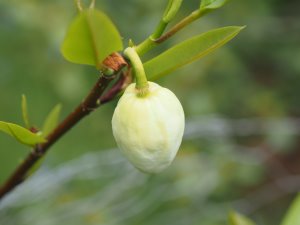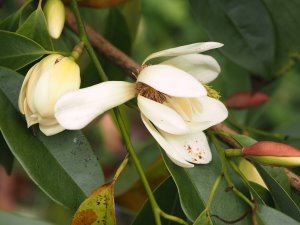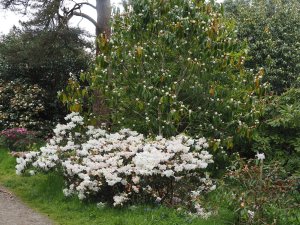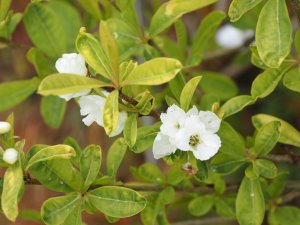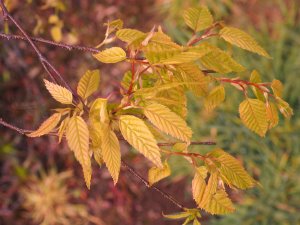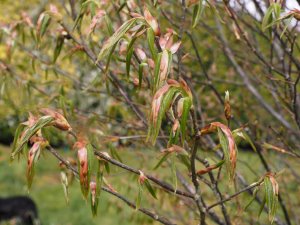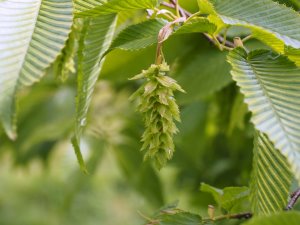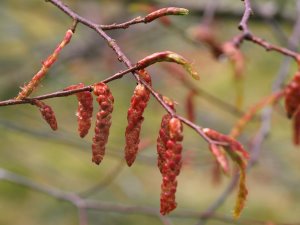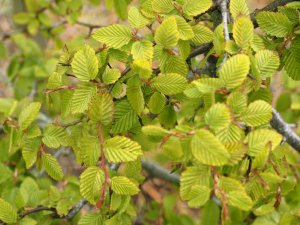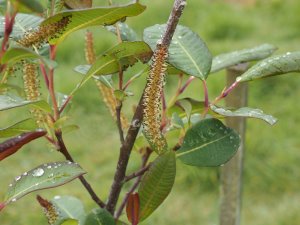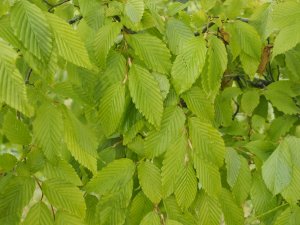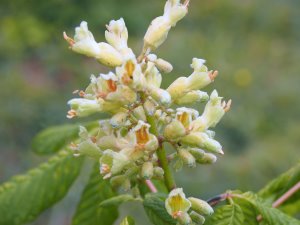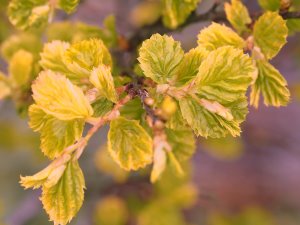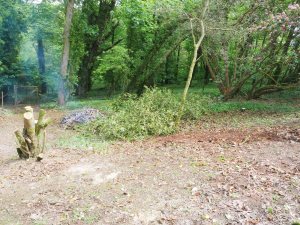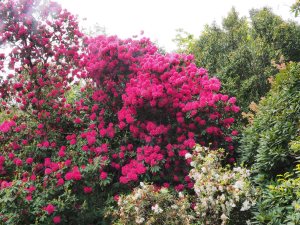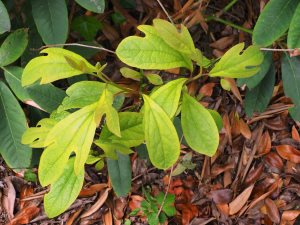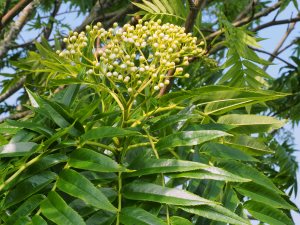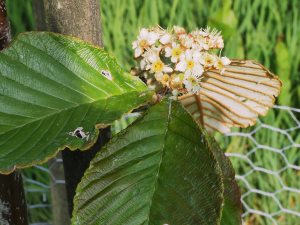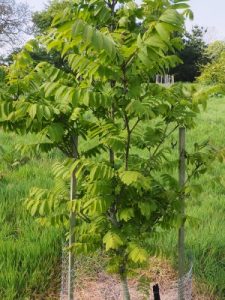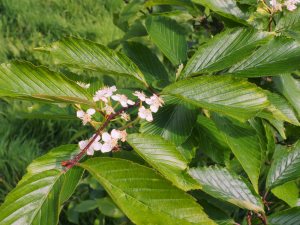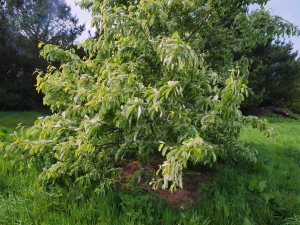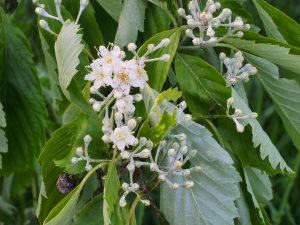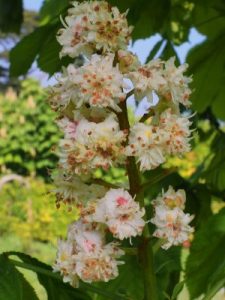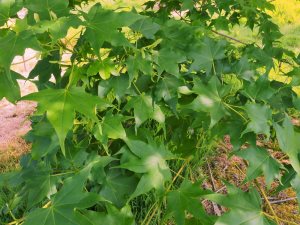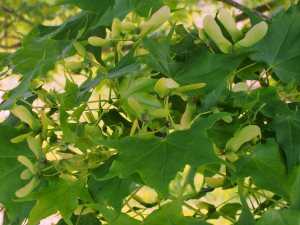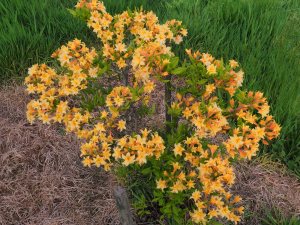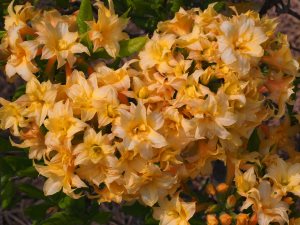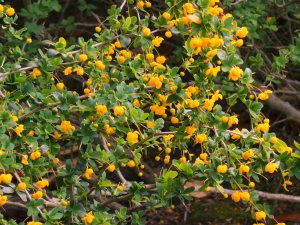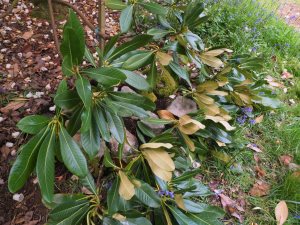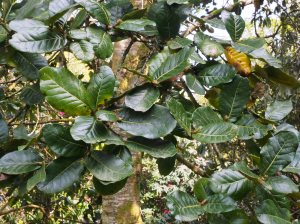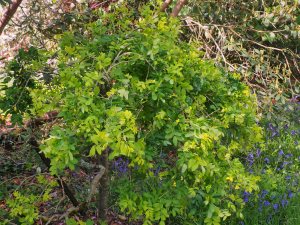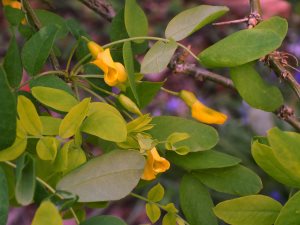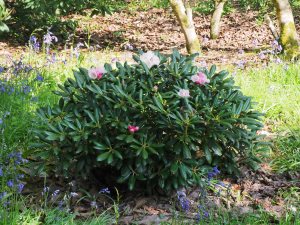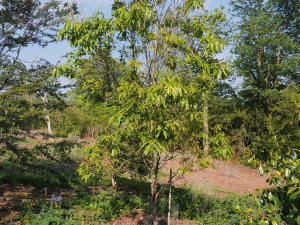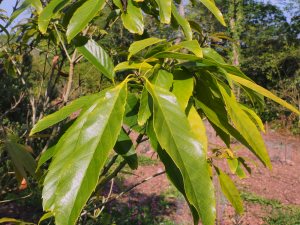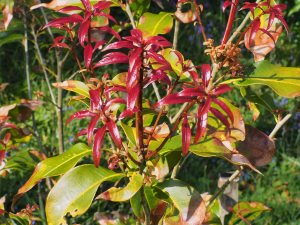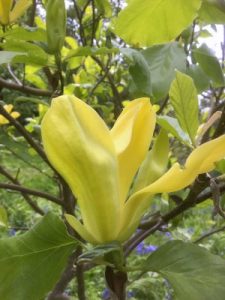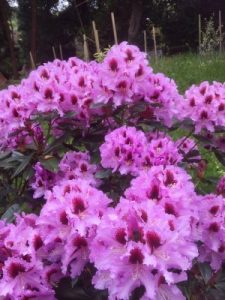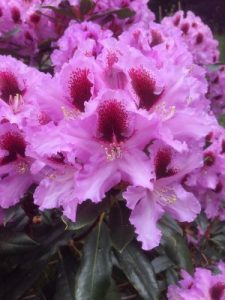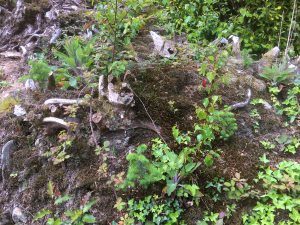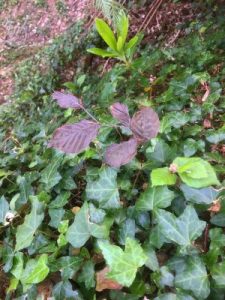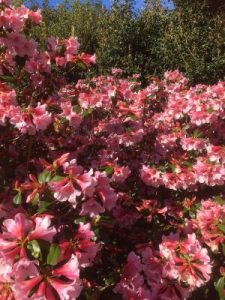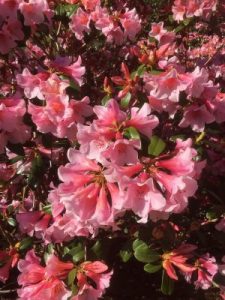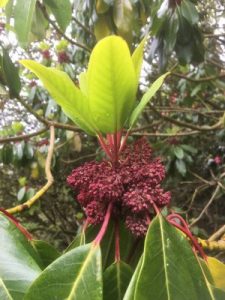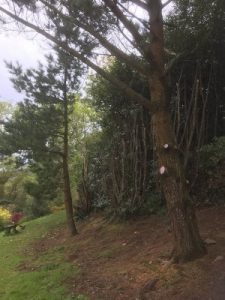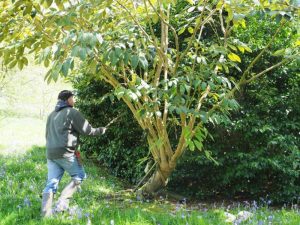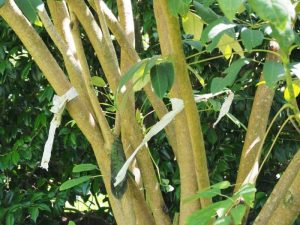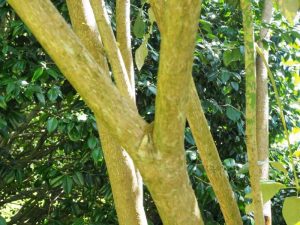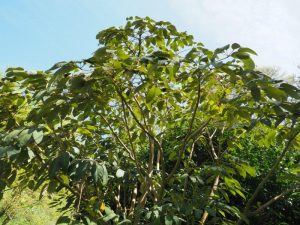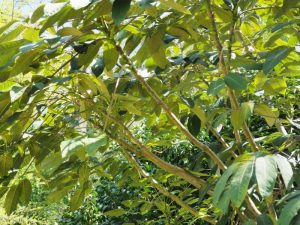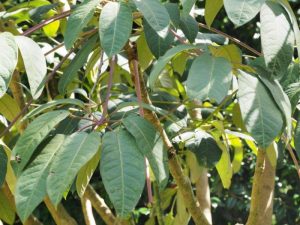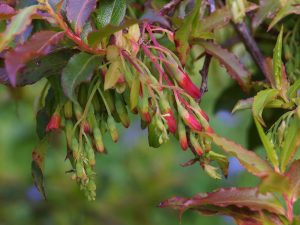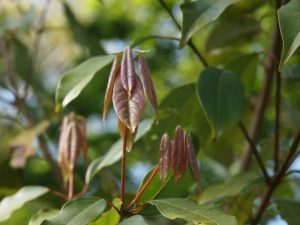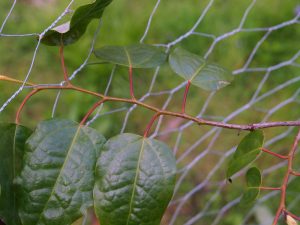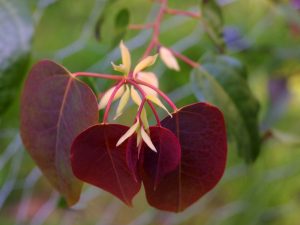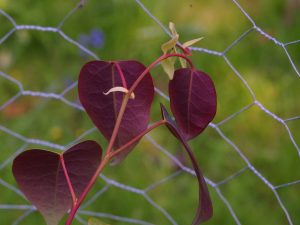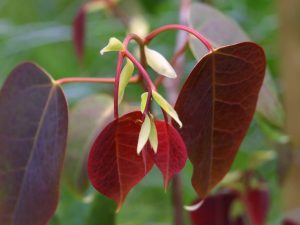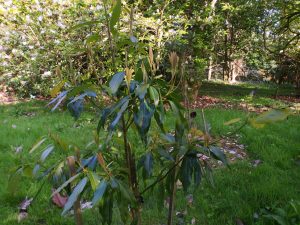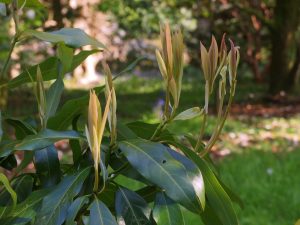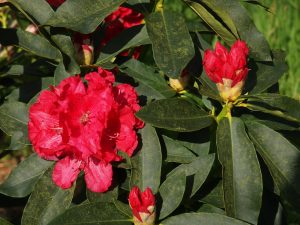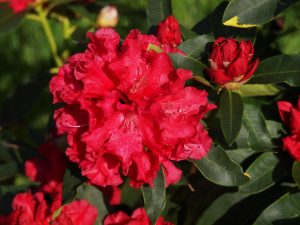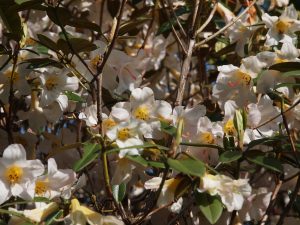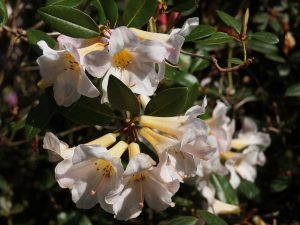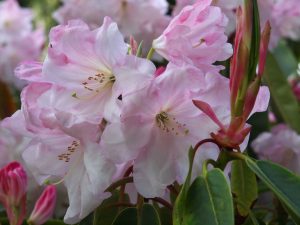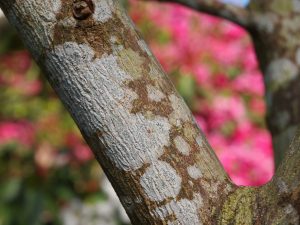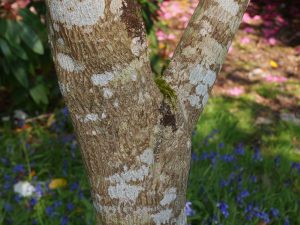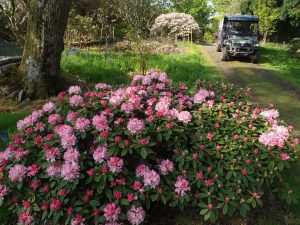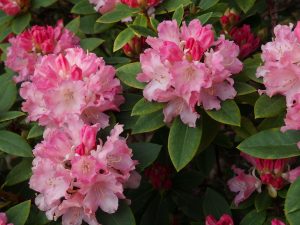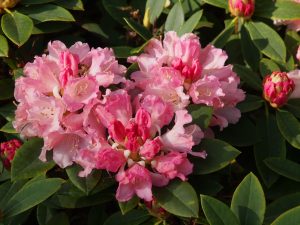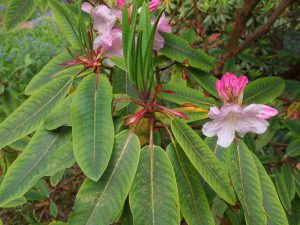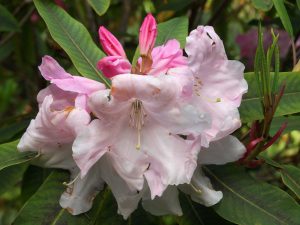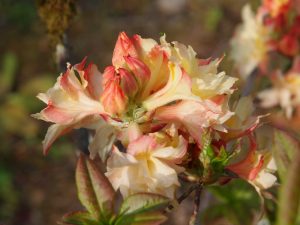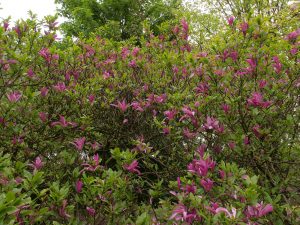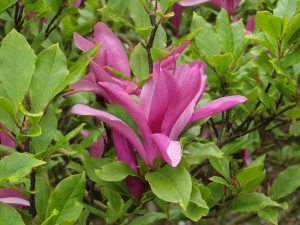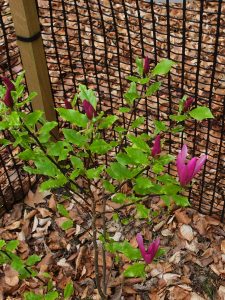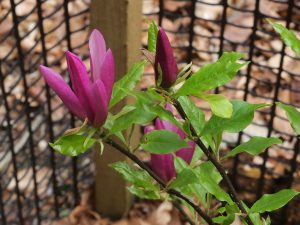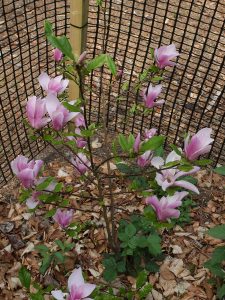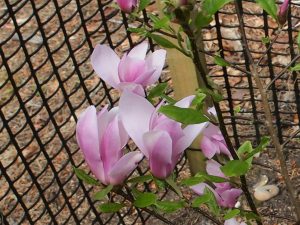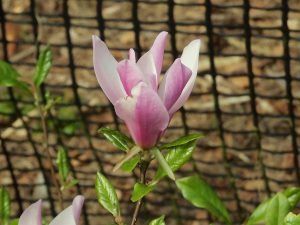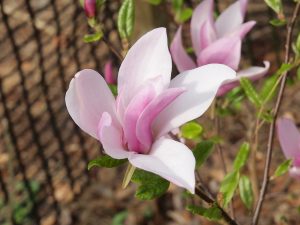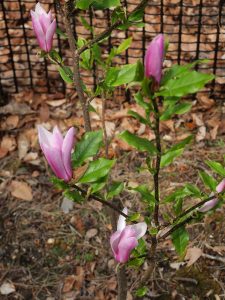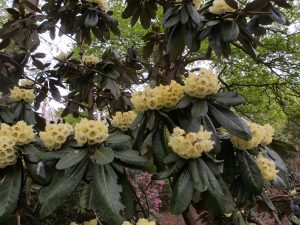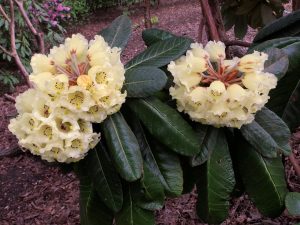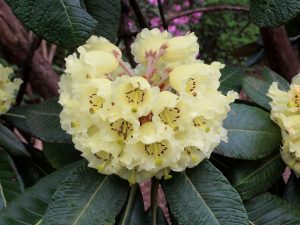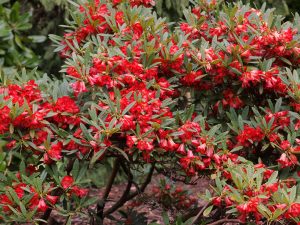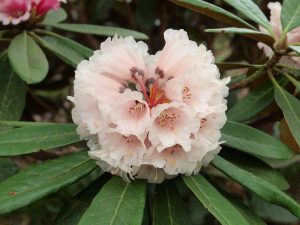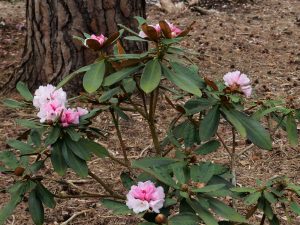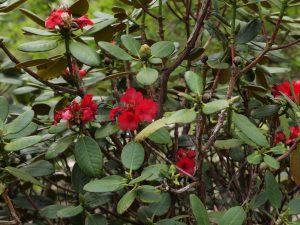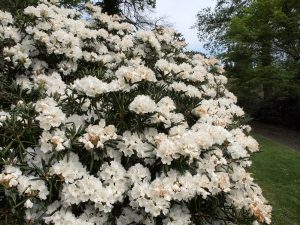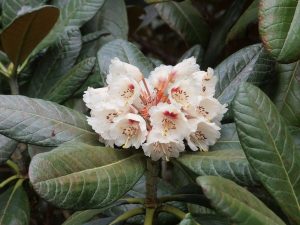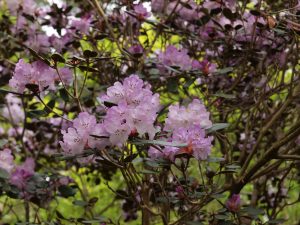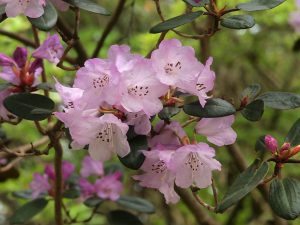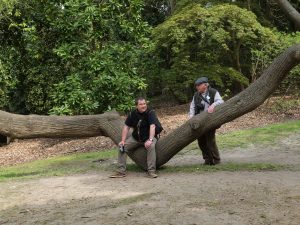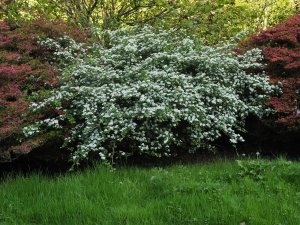
The view from the entrance to the (Upper) Rockery today – stunning!
Glorious day. The rhododendron flowers have responded overnight to the heat.Rhododendron serpyllifolium on the drive with its tiny pinkish flowers.
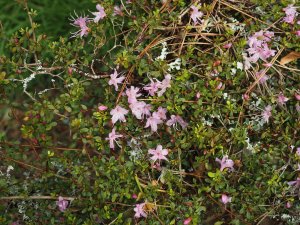
2022 – CHW
We saw flowers last week on M. ‘Southern Belle’ and here is Magnolia ‘Summer Solstice’ also just out and very similar in appearance. The latter is supposedly M. obovata x M. globosa? while the former is a cross between M. sieboldii and M. tripetala x M. obovata. I doubt there is much globosa in ‘Summer Solstice’.
After a full day’s rain at last the garden looks much happier. The leaf has shot out and new growth appearing everywhere. Much flower-drop on the rhodos. I thought we might look today at the Carpinus species coming into leaf and see if any had flower tassels.A new species of Exochorda to us planted in 2019 in Tin Garden – here Exochorda tianschuanica.
One learns something totally irrelevant every day! Ucodendron whartonii, which flowered here for the first time last year, is now considered to be Disanthus ovatifolius. We had been told that the botanists thought it was a Parrotia which made some sense in relation to its flowers. Now the ‘new’ 2019 ninth edition of Hilliers says that D. ovatifolius is a tree although it looks like a climber or a multi-stemmed straggly plant to me! It was found in 2006 and sold by Crug Farm Plants (rather before the date of 2017 as stated in Hilliers). A 2016 Vietnamese survey confirmed this new name on the basis of the ‘leaf shape’. We will see what it grows into in the next decades! I bet that the name changes again shortly! Ucodendron had a nice ring to its name! Hilliers do not mention its exceptional new growth colours or the purple undersides to its leaves which are also quite outstanding. Disanthus cercidifolius is a plant noted for its autumn colours which we have failed to grow despite three attempts. The plants I saw at High Beeches in Sussex last spring (and previously) were outstanding but D. cercidifolius has little to recommend its flowers. I suppose that it is, however, a multi-stemmed large shrub (like a Corylus). Anyway much fun to be had here disagreeing with the botanists. If you search this garden diary you will find plenty of pictures of Ucodendron whartonii and its peculiar flowers.I had an email from the RHS asking if our ‘head gardener’ might like to share information on the performance of ‘new’ plants for the 10th edition of Hilliers. I said, in reply, that some / a little of what is supposedly new in the IDS ‘New Trees’ book has actually been growing here for 80 to 100 years. Nobody asked! So now I suggest that I might actually know what is growing here ‘myself’ and they could, in fact, ask me! How typical of the RHS Wisley to assume the private garden owner is too ‘thick’ to know what is actually planted in his own garden and hope to rely on other staff to help. They get the proverbial ‘finger’ but I do hope to be able to help with our specific knowledge of new and unusual plants here of which there are plenty to enjoy! The last job in lockdown if the RHS will actually give me a list to work with?I am now a day away from finishing checking all our photographic databases for mistakes, new care articles, better pictures for the website etc. Without lockdown this would not have been achievable. As it is 1,500 better/new pictures added to the website in 40 to 50 hours work dealing with 30-40,000 (?) pictures from various in house sources over nearly 20 years.The swallows are (both) back in the dog kennel and twittering away with delight. Two green woodpeckers on the lawn chasing ants.A bonfire to clear a space to plant our Rhododendron ‘Mrs Butler’ layers in the autumn where a beech tree split in half. Jaimie’s team still has to fell a couple of overhanging trees and to pollard an elderly rhododendron.
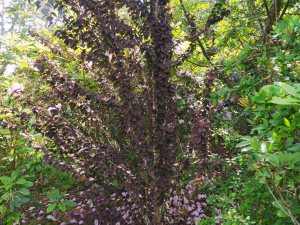
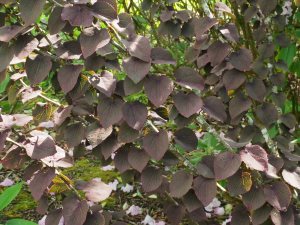
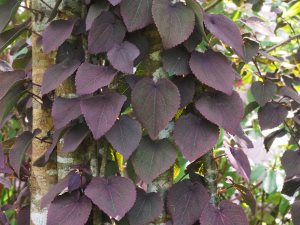
I had been hunting Magnolia ‘Green Bee’ for some weeks and finally found it well up the drive. Although greenish in bud it really is a very good yellow.
Went with Jaimie to sort out which branches to cut for Chelsea from the huge Schefflera macrophylla tree in Forty Acres. The leaves are all intact and untouched by the cold winds in February/March. We select one upright branch and one side on branch to cut which we mark with white plastic. We will cut these branches on Thursday 17th May first thing. Then they can be inspected by Defra before loading onto the third and last lorry load for Chelsea which will arrive at Chelsea first thing on Friday 18th. The branches, and those of Schefflera taiwaniana, will travel in a dustbin of water. We are confident that they will not flop before or during the show based on past experience of cutting bits off this unusual plant which will seldom if ever have been seen at Chelsea before at this sort of size or age.Schefflera are very new to cultivation in the UK and have proved themselves totally (if unexpectedly) hardy during ‘The Beast from the East’. In time these will definitely become very popular garden plants.
A very happy and interesting visit to the rhodo species collection at Windsor Great Park and then onto the Valley Gardens and, finally, the Savill Garden. The latter had matured enormously since my ‘gap year’ as a student gardener nearly 40 years ago but the species collection has matured slowly and I enjoyed visiting the borders I once helped double dig all those years ago. Harvey Stephens is just the sort of person to take on this, clearly and self-evidently, best garden in England, with his new boss (ex Exbury) John Anderson. They will be in the Eric Savill, John Bond, Mark Flannigan mould and maintain the amazing levels of excellence not least in the labelling and cataloguing of the collection. This is where I taught myself many of the plant names which Burncoose sells today. Harvey called me an ‘unusual’ student gardener. 40 years ago there were 60 gardeners and 20 students. Today 16 gardeners, two bosses and three students (but the grass cutting etc is contracted to others). I was amused to see that most things in ‘my’ rhodo beds had not survived 40 years! One of my first jobs was to plant the new American ‘girls’ in the Heather Garden. These were crosses between Magnolia stellata and lilliflora nigra and have achieved 15ft spans, 10ft or so high in 40 years. There are nine named girls and we saw the lot. They are more different than you think when you see them all together but easily muddled. It might have been better just to have named three or four. Here are the five still flowering decently today:
The best rhododendrons flowering in the species collection were: Rhododendron cinnabarinum subsp xanthocodon Purpurellum Group
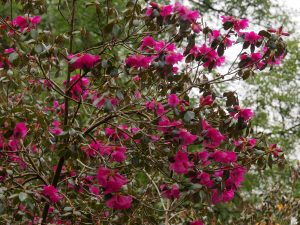

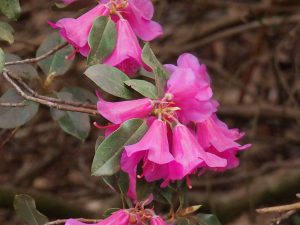
I need to spend a couple of days here next spring for a more in depth review of what I have forgotten about rhodo species. It is excellent that Jaimie has been a student friend of Harvey for many years. This ensures the Caerhays-Windsor connection and friendship will continue as it always has.I leave you with Karol ‘resting’ in the Valley Gardens.
2015 – CHW
A trip around the garden with a nice group of fairly non gardeners who had bought their tour at a charity auction. The purchaser was responsible for setting up the polling station in the castle over five years ago which was twittered worldwide at the time and raised some money for their charity. Heavy rain early morning (good) but now a warm north wind.
Their granddaughter likes pink so we look for pinkish and smelly plants.
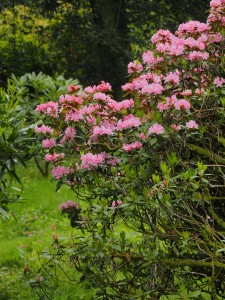
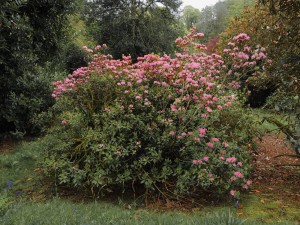
Rhododendron chapmanii is a relatively unknown species with a compact habit.
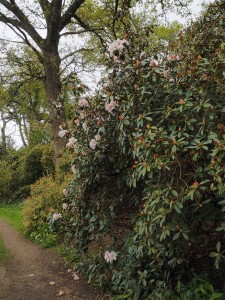
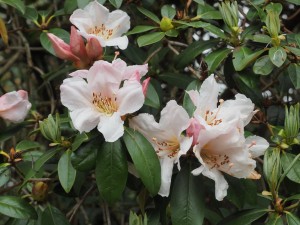
Rhododendron crassum is pink in bud and the smell was just coming. Too far out already for Chelsea though.
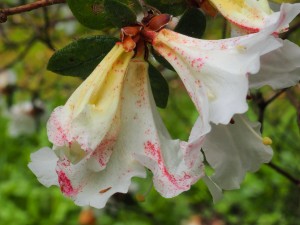
Rhododendron ‘Berts Own’ is nearly over so much of the pink flashing had faded but the scent was still knock-out. You would not stick is indoors for long. A Caerhays hybrid from the 1950s or 1960s I think.
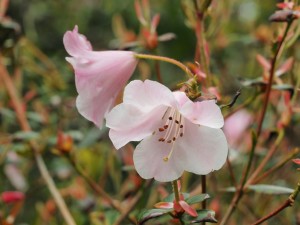
williamsianum x callimorphum
Rhododendron williamsianum x callimorphum – as usual you walk by plants all year which you think have been lost or died out only to discover they have not. Williamsianum x martinianum now located too on Burns Bank so this is not lost to us either.
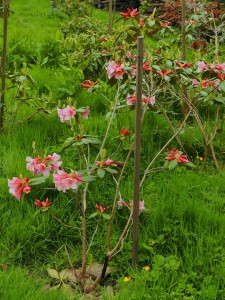
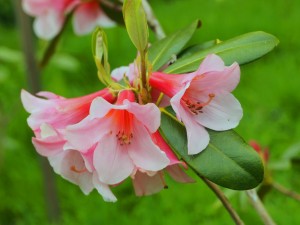
Rhododendron ‘Polyroy’ – a Millais Nurseries bred hybrid of excellent quality flowering with us for the first time. Presumably Rhododendron polyandrum x Rhododendron royalii although I have not yet looked it up. There are a few flowers left on Magnolia acuminata ‘Fertile Myrtle’ x sprengeri ‘Diva’ and so I ask the group to suggest a name to register this with the Magnolia Society International. They come up with ‘TROPICANA’ which is PERFECT and I will give them all the credit when we register. Out of the hundreds of people who have been asked this same question in the last five to six weeks only they came up with anything faintly resembling the actual colours in a simple word. Well done them!
2000 – FJW
Have never seen more flower or colour in the garden – went around with Philip.
1998 – FJW
Garden closed – on everyday the garden was open, RAIN FELL. Beech trees coming out.
1993 – FJW
Hot week saved by some showers.
1990 – FJW
Very dry – limited bad weather coming limply from the north.
1965 – FJW
The best new thing has been the Diva x Robusta above the Stables. The Mollicomata x nigra is ordinary but precocious to flower so young. The Dalhousiae hybs. not so good as the first attempt. The ‘yellow’ seedling azaleas on the Drive are at least yellow!
1916 – JCW
Auklandii nearly over, Cherries are gone. White A indica and A amoena very good. Molli and Ghent Azaleas nice. Loderi going over. Falconeri opening. Augustinii is passing. Daffs have gone.
1909 – JCW
Tubergen Iris are very good, most other things ruined by the sun and dry wind. C reticulata over, Montana rubra coming, Auklandii ⅓ open, Recurvas open, other things (daffs) over.
1901 – JCW
Picked the first seed pods, H Irving under glass.




